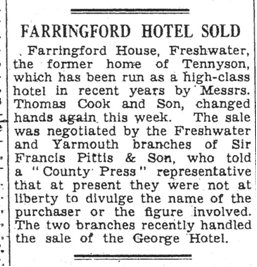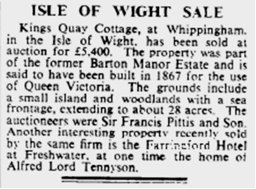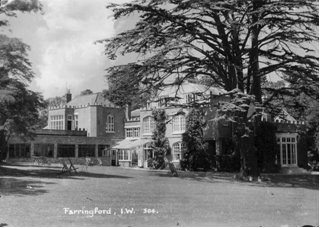In May 1960, Sir Fred Pontin bought the hotel:
 [The Isle of Wight County Press, 14 May 1960]
[The Isle of Wight County Press, 14 May 1960]

[The Times, 20 June 1960]
Very shortly after Pontin took over, extra dining capacity was added in the form of a large modern single story extension on the south side of what had been Tennyson’s “music room” or “ballroom”. This replaced the previous, more modest, extension to the dining room made in 1952. Made from differently-coloured brick, such an obtrusive addition led to the south side of the house looking “confused”(Buildings of England: Hampshire and the Isle of Wight by Nikolaus Pevsner and David Lloyd. Penguin, 1967).

In 1987, Graham Parr and Trevor Hemmings, a multi-millionaire racehorse owner, purchased Pontins for £57.5 million, becoming major shareholders. In 1989, they sold it off for £115 million to the UK beer and leisure group Scottish & Newcastle. The now-obsolete company Alpine Soft Drinks, which had been acquired by Pontin, purchased Farringford Hotel in the 1980s and became known as ‘Farringford plc’. In the early 1990s, Trevor Hemmings bought Farringford at 4p a share, when it was a loss-making shell company. In 1997, Hemmings and Parr changed the company’s name from ‘Farringford plc’ to ‘Arena Leisure’, incorporating the management of a racecourse, Lingfield Park. Subsequently, Arena acquired further racecourses: Folkestone, Wolverhampton, Southwell, Worcester and Royal Windsor.
On 15th November 1999, in order to help reduce the Company's debts, Arena Leisure sold off Farringford Hotel for a cash consideration of £950,000 to a consortium, made up of Lisa Hollyhead, Dean Hopkinson and Rachael Fidler. Their aim was to focus on business tourism and conference-hosting, as well as expanding further into the wedding market.
Rebecca FitzGerald bought the hotel in 2007, before closing it in 2009. Over the ensuing decade, Ms FitzGerald has overseen the restoration and redecoration of Farringford to its 19th century state, with the aim of reopening to the public as an historic home.
Based on the ‘Analytical Record’ of Farringford by Robert Martin: